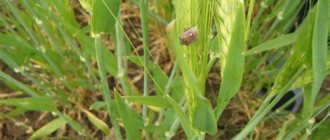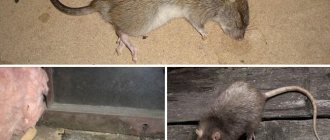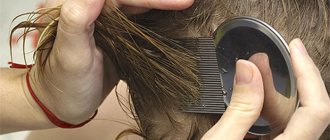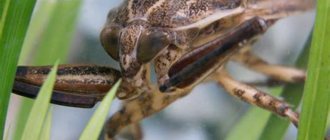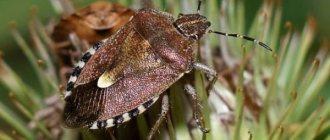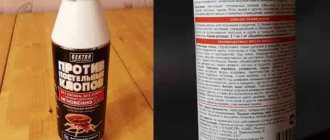Description and external differences of the soldier bug
The soldier bug (in Latin Pyrrhocoris apterus) belongs to the red bug family. This is one of the types of common ground bugs. The insect has many names. Because of its bright red and black coloration, it is called the fireman bug or the red bug. And due to the lack of wings, it is sometimes called the wingless red bug.
The soldier bug looks like a small (9 - 11 mm) bug with a rounded, flattened body. The body is black, with a black and red pattern on the elytra and back. The pattern consists of spots of various shapes (circles, triangles, stripes). The eyes are red, the paws and whiskers are black. The mouthparts are piercing-sucking.
Appearance
Who can be confused with?
The soldier bug is often confused with two types of insects:
- The henbane bug is very similar in appearance and size to the red bug. The main external differences are a triangular head with a large red spot and darker eyes, not red, but brown.
- The fire beetle is a representative of the soft-bodied family, having a red and black color. This insect has quite a lot of external differences from the soldier. The beetle is larger (reaches 1.6 cm), it has a more elongated body, black elytra, and the abdomen and legs are red or brown.
If it’s really easy to mistake a bobwhite for a soldier, then in the case of a soft-bodied fish, the main confusion arises from the name, since both representatives of arthropods are popularly called firefighters.
How to get rid of it: effective methods of control
Firstly, it should be remembered that these insects can harm the future harvest and very seriously. First, you need to accurately determine that the pest is the wingless red bug, since garden crops are damaged by other, more dangerous insects.
Plant infection is determined by a number of signs. For example:
- Beet shoots die quickly.
- First, the leaves begin to curl inward.
- Umbrella crops such as dill and carrots also disappear quickly.
- The buds of garden flowers begin to fall.
- Cabbage heads are starting to suffer from yellow spot.
Mechanical removal method
If there are not so many wingless red bugs in the area, then you can catch them by hand, although this will have to be done for several days in a row. Despite the fact that this method of fighting takes a lot of time, it is considered quite effective.
Hunting belts
Catching belts are used to protect garden trees. They can be purchased at a retail outlet or made yourself. To make such a simple device, you will need a piece of corrugated cardboard, up to 25 cm wide. The cardboard is cut across the grooves, after which office glue is applied. On the reverse side, glass wool, up to 1.5 cm thick, is attached to the cardboard, after which the belt must be secured to the tree using wire.
Control with insecticides
If there are too many soldier beetles, you will have to use toxic substances such as insecticides. The Japanese remedy “Bankol” is considered a fairly effective drug against soldier beetles. The basis of this insecticide is the substance bensultap. The product is sold in sachets of 10, 25 and 100 g and is a white or cream-colored powder. The drug paralyzes insects and after a couple of days they die.
The advantages of the product include:
- This toxic substance does not pose a danger to humans or to many beneficial insects, such as bees.
- The product does not have an unpleasant odor.
- Its components do not accumulate in the ground. It can be used in hot weather.
For 10 liters of water you need to take 5-7 g of the substance, but before that it should be mixed in a small amount of liquid. The product is sprayed onto the plants. Consumption of the substance is 5-10 liters of solution per 1 sq.m of garden.
In addition to Bankol, other drugs are also suitable, such as:
- Actellik.
- Karbofos.
- Aktara.
These insect control agents are harmful to humans, so you can work with them using personal protective equipment. The working composition must be prepared strictly according to the instructions.
Folk remedies
Folk remedies prepared according to folk recipes are not toxic compared to chemicals.
Effective recipes:
- Take 10 liters of water and 200 g of onion peels. After this, the product is infused for about 5 days. The infusion is filtered and the plants are sprayed with it every 5 days.
- For 1 bucket of water, take 100 g of mustard powder or wood ash. Plantings are treated with this solution.
- Take 300 g of soap per 10 liters of water and dissolve it, after which the plants are treated with this solution. There is another option: the trimmed area is sprinkled with crushed pieces of soap, after which this area is watered. After this, you need to throw a piece of fabric over this place, the bugs will start running out and get on the piece of fabric. All that remains is to quickly collect the fabric along with the bedbugs and throw it away.
When it’s hot outside, the intensity of treatment can be increased by waiting until the soil dries well.
Habitat
Red soldier bugs live over a vast territory from polar latitudes to the tropics, but they are especially common in regions with temperate climates. They can be found in Russia, the USA, European countries, India, northern Africa, and China.
Main insect habitats:
- old stumps, fallen trees;
- under the bark or in the hollows of trees;
- in dry grass and fallen leaves.
Soldiers can also be found on wooden fences, in bathhouses, gazebos and outbuildings. For the winter they hide in the soil, under stones.
What does a soldier bug look like (photo)
They look really dangerous, but are completely harmless. The size of the soldier bug can be from 3 to 20 millimeters. The flat, elongated body is bright red in color, the upper part of the body is usually hairy. The flat head of insects is narrowed at the base. The pronotum is already wide, slightly shiny and finely ribbed elytra, between which there is a shallow middle furrow. All bedbugs have six legs; by this feature they can be distinguished from ticks, which have 8 legs. The larvae are three centimeters in size and are long-tailed, highly flattened, mealworm-like insects.
Scientists have long paid attention to these fiery insects:
- bright black and red colors signal to predators: I am inedible! Soldier bugs have stink glands on their abdomens, the secretions of which spoil the birds' appetites and act as a contact poison that causes paralysis in other attacking insects.
- the coloring and, above all, the pattern vary greatly; especially the black spots on the wing wings depend on external conditions as well as temperature
- Soldier bugs are found in all warm and temperate countries of Europe
In 1891, Heinrich von Henking discovered an unusual chromosome while studying the red bug that resembled an "X". This was the first time it was proven that there is a connection between sets of chromosomes and gender.
In the mid-sixties of the last century, Karel Slama made a remarkable discovery: soldier bugs kept in terrariums on paper from Europe developed normally for adult insects, while bugs that lived on American paper remained in the larval stage or died. The findings were very interesting. The reason is that American paper was made from balsam fir wood. And this, in turn, produced hormones in the gluttonous beetles that inhibited development. Amazing realization: plants can protect themselves from intruders!
In recent years, researchers have discovered that soldier bugs produce certain chemicals, peptides, to protect against bacteria. Experiments on mice have shown that these substances can protect insects from coliform bacteria and salmonella. Now the researchers hope that these peptides act against bacteria that are immune to antibiotics.
Reproduction and life cycle
Red bugs live 12 – 14 months. Their life cycle consists of several stages:
- egg;
- larva;
- adult.
Overwintered insects wake up quite early at the end of March or beginning of April. In May, females lay eggs. To mate, the male and female are attached to each other by the rear parts of the body. They can spend from several hours to several days in this position.
For laying, the female chooses places where it will be easier for the hatched larvae to obtain food (for example, plant leaves). A clutch usually contains from 15 to 30 eggs. Within 6–15 days, young individuals are born, begin to actively feed and develop rapidly. In the second half of June, young females continue breeding.
What does it eat?
Based on what soldier bugs feed on, they can rightfully be called polyphagous. The diet of red bugs includes:
- pollen;
- plant juices;
- seeds;
- berries and fruits;
- worms, snails;
- insects.
Nutrition
Sometimes their relatives become victims of soldier bugs.
Habitats
Beetles, popularly called soldier beetles, are most often encountered on the street or in the garden. They nest in old rotten wooden logs, tree trunks or plank fences. Sometimes such surfaces are literally strewn with colonies of soldiers.
But in these places, insects just rest, but to obtain nutrients they go hunting, depositing young growth in the garden and causing irreparable damage to the crop in the garden. Gardeners often find soldiers in cabbage , carrot or beet tops, on the leaves of garden trees or currant bushes. In any case, if the owner of the site discovers colonies of soldier beetles nearby, he should immediately think about how to drive them away.
Despite its outwardly harmless appearance, the bug causes serious damage to garden crops. The insect lays eggs directly in plants (on leaves or stems), while simultaneously sucking out all the juice from them. They are especially dangerous for elite grape varieties. Due to the fact that they feed on the juice of garden crops, they are classified as serious pests. The gardener must understand that it is not so much the adult soldier bugs that cause harm, but rather their eggs and larvae. And for this reason, their appearance in the garden area should be prevented in a timely manner. Often these garden pests cause damage to young shoots of beets, carrots, dill and other garden vegetation. Plants that have not yet become strong and have not gained vitality simply die from the influence of soldiers.
What does the soldier bug eat?
In order to effectively combat garden pests, it is necessary to understand what these insects eat and where do they live?
The red beetle with black spots, popularly known as the soldier bug, is completely unpretentious in food. Few people know what soldier beetles eat, but this information is very important, especially for gardeners who can suffer significant losses from black-and-red pests.
So, in order to exist fully, the red-black beetle only needs plant sap. He obtains it by piercing leaves or stems with a sharp proboscis. After such an impact, the cultivated vegetation stops bearing fruit and gradually dies off. If soldier beetles damage vegetable, fruit or berry fruits, then they cease to be suitable for consumption. If there is no fresh sap nearby, then black-and-red bugs can even eat carrion. Bed bugs gather in colonies on dead insects, and sometimes they can even be seen on the corpses of vertebrate animals. Oviposition is done by this insect directly on the leaves, cuttings and stems of plants. This prevents the risk of food shortages for the young. Young red larvae will always find something to eat, thanks to this placement of oviposition. Gathering in large colonies, they cause irreparable damage to many garden and vegetable crops:
What are the benefits and harms of the soldier bug?
Speaking about the dangers of the soldier bug, it is worth explaining why exactly it is dangerous:
- as a result of sucking out nutritious juices, the plant dries out, stops blooming and bearing fruit and dies over time;
- fruits affected by insects wither and become unfit for consumption;
- insects can pierce even the dense seed shell, therefore damaging the seedlings.
Red bugs infect a large number of different plants, but they cause the greatest harm to vineyards.
But soldiers can also be useful. They consume rotting fruits that are on the plant or fallen to the ground, and destroy some insect pests.
Signs of the appearance of soldier bugs in the garden
The surest sign that there are soldier bugs in the area is the direct detection of insects. But even without seeing the pests themselves, you can guess their presence by the following signs:
- yellow spots appear on the cabbage, the upper leaves dry out and die;
- leaves of plants of the umbelliferous family (dill, coriander) begin to dry;
- carrot and beet tops dry out and become deformed;
- flowers and buds of plants wither and fall off;
- young seedlings grow poorly;
- berries and fruits rot or dry out.
If the plant is severely affected, it is best to dig it up and destroy it to prevent further spread of pests.
Methods of fighting bedbugs with soldiers
Having understood what and how the red bug feeds, you can easily imagine the future damage to your garden if colonies of this insect spread throughout the territory
This means that when you see a red bug on your property, it is important to begin combating the spread of its colonies as quickly as possible.
Colony of soldier bugs on a dry stump
Next I would like to cite one interesting fact. Over the past decades, the soldier beetle has not been included in the general register of pests, since it was believed that this insect feeds exclusively on seeds or fruits that have fallen on their own. However, recently, scientists have been able to prove that the red bug has begun to mutate and reproduce more actively, destroying crops and many adult plants. And that means the fight against insects has become more urgent.
To destroy colonies of red soldier beetles, you should first make sure that these are the pests that are destroying your plants. There are several main signs by which red bug damage to a plant is recognized:
- flowers (as well as buds) of most crops can fall off almost immediately after appearance if the plant is parasitized by a soldier larva. Naturally, this leads to loss of harvest,
- most umbrella plants (such as coriander or dill) are incredibly sensitive to this pest and can die completely in the shortest possible time,
- Carrot and beet seedlings usually die immediately (after red bugs parasitize them), but in extremely rare cases they can significantly lag in growth and produce a small harvest. In this case, mature plants will always have curled leaves.
You should think about destroying the red bug population in the spring, when the harm they cause is barely noticeable, otherwise the problem will emerge in the summer, after the fruits ripen, after the mass flowering of ornamental plants, etc.
To prevent soldier beetles from getting on important garden crops, experts recommend planting the latter as far as possible from alfalfa or perennial legumes. And all because the bug prefers to overwinter on such plants
It is important to mow the alfalfa itself (any weed) as low as possible, as this allows you to destroy the eggs and larvae of the toy soldiers
A plant that repels soldier bugs is black cohosh.
If the plant has already been infected with soldier larvae, it can be treated with the drug “Bankol”. This substance is without an excessively pungent odor, safe for humans and pets. By the way, “Bankol” is often used to destroy the Colorado potato beetle, which indicates its incredible effectiveness.
Another interesting option for fighting soldiers is to plant black cohosh in close proximity to useful and important crops. This perennial plant, belonging to the buttercup family, will quite effectively repel the bug with its own smell.
Please note that this type of bug is not at all dangerous to people. It does not settle in a person’s home, does not bite and, in general, does not cause harm to humans. If a random soldier gets into a living room, you just need to take it out - this beetle will not bother the person again.
How to get rid of soldier bugs in the garden?
Some gardeners do not consider red bugs to be dangerous pests and do not fight them. But those who have encountered soldiers before and know what harm they can cause try to immediately get rid of them, using both special and folk remedies.
Natural enemies
Their natural enemies can help in the fight against soldier bugs. Among them are birds, bats, praying mantises, and spiders. But thanks to their bright coloring, as well as the ability to secrete a secretion with a strong unpleasant odor, red bugs are well protected. For example, tits do not eat soldiers because of their smell, and many spiders simply throw them out of their web.
Pest control agent
Chemicals
Special chemical agents are most effective against red bugs. But their use can have a negative impact not only on pests, but also on beneficial insects, as well as on the soil and the plants themselves. Therefore, when choosing a drug, you need to pay attention to its toxicity, follow the rules of use, dosage and frequency of use.
The following medications help get rid of soldier bugs:
- Bankol;
- Aktara;
- Karbofos;
- Malathion;
- Actellik.
Attention! During processing, you must use protective equipment - a mask, gloves.
Light traps
Another way to control insects is to use traps (both with regular light and with ultraviolet light). The operating principles of these devices are different. In a conventional light trap, insects crawl in, attracted by the light, and then either stick to a sticky surface or are sucked in by a fan. Ultraviolet radiation also attracts insects, and once inside the trap, they die from an electrical discharge.
Traditional methods
Many gardeners prefer to use traditional methods in the fight against soldier bugs, as they help get rid of insects without poisoning the plants and soil.
The most popular means:
- infusion of onion peel;
- wood ash;
- soap solution (from laundry soap);
- mustard powder.
In addition, sticky tapes are used that are wrapped around trees where bedbugs have settled.
Can soldier bugs cause any harm?
The soldier bug is a beetle belonging to the order Hemiptera.
The body length of the insect is from 7 to 12 mm. Amazing color is the distinguishing feature of the soldier bug. The red bug, whose characteristic feature is a red and black pattern on the back, loves to live in the bark of trees or among garden crops. It lays larvae that do not resemble the adult in appearance. The larvae of the soldier bug are mainly red in color, but sometimes there are dark dots on the surface of their body.
Soldier insects have a mouth in the form of a piercing-sucking proboscis. If the bug is calm, then this proboscis is located in a horizontal position at the bottom of the head. Using their proboscis mouth, soldier bugs pierce through the shell of plant elements or even the chitinous cover of dead insects. The beetle sucks out the remaining juice from them.
An insect such as the soldier bug has become quite widespread. They prefer to live in groups and colonies. Collectively, these bugs attack garden plants, and also go to winter in a group. In the summer, red bugs love to bask in the sun, crawling out into open areas of the area.
Usually this insect does not harm anyone and touches everyone with its appearance, especially children. But people who are practically familiar with its activities treat this insect completely differently. His appearance does not correspond to reality in any way.
The picture shows a column of soldier bugs
Living plants are what soldier bugs love. How to get rid of them? In order to answer this question, it is necessary to understand in detail what they actually do.
Previously, it was believed that the soldier bug feeds only on fallen fruits and dead insects. But scientists soon found out that it also feeds on young plants. Therefore, you should get rid of it immediately.
- During reproduction, the soldier bug lays its eggs directly inside living plant tissue. This occurs directly in the leaves or in the inner part of the stem.
- Young bugs use the sap of living plants as the food they need. To do this, they use a small proboscis.
- After the bug sucks the juice from the plant, it immediately begins to die. Since juice is its necessary component for normal life.
- Newly hatched bed bugs feed only on weeds. But when warmer weather arrives, they don't mind eating healthy, bright green plants. Moreover, it doesn’t matter to them what kind of plant it is. Almost all species are used for their food. This is why gardeners don’t like soldier bugs so much.
- Most of all, bugs attack vineyards. This way they can be detected very often. They can also spoil various fruits and berries, leaving their larvae there.
- If the bugs do not find healthy plants, they begin to feed on dying plants or insect corpses.
Based on this, we can conclude that the soldier bug is a rather dangerous pest for plants. And it is necessary to fight it. A dangerous type of pest is soldier bugs.
How to get rid of soldier bugs in a house or apartment?
Since there are most often one or several soldier bugs in an apartment, getting rid of them is not difficult. Simply sweep the insect into a dustpan and throw it outside or flush it down the toilet. In rare cases, when soldiers have settled in the house and began to reproduce, both chemicals and folk remedies will help get rid of them:
- Dichlorvos or other insecticides that can be used indoors;
- fresh or dried herbs (wormwood, tansy) are laid out in the rooms.
Sagebrush
If red bugs have chosen seedlings or indoor plants, you can use an infusion of onion peels or a soap solution to treat them.
Ways to get rid of red bugs
Despite the fact that the soldier beetle is harmless to humans, it can cause significant damage to the garden. Living plants are what this bug loves. How to get rid of it interests almost all gardeners. Before you start getting rid of them, you should first make sure that they are the ones besieging the area. There are several characteristic signs of plant damage by soldier bugs:
- all shoots of beet tops either lag behind in growth or curl and simply dry out;
- flower buds begin to fall off quickly;
- any umbrella plants dry out quickly;
- Cabbage leaves become covered with yellow spots over time.
Even if the harm is not very noticeable at the very beginning of its appearance, it will appear in full force during the ripening of fruits and flowering. Therefore, to prevent the penetration of bedbugs, it is best to plant garden crops at a great distance from legumes and alfalfa, since in winter bedbugs usually sleep on them. And in the summer they can easily move to crops.
Stores sell catching belts that are also used to combat bedbugs. The traps are attached with wire at the bottom of the tree trunk.
You can also treat infected areas with Bankol. It is safe and does not have a strong odor. Dilute it according to the instructions. After spraying, bedbugs die after 1–3 days. Bankol also copes well with the Colorado potato beetle.
Another good option is to plant black cohosh next to crops. It effectively repels soldiers with its scent.
Traditional methods
There are gardeners who use simple folk remedies to get rid of beetles:
- One of the popular remedies is a soap solution; 300 g of laundry soap is diluted with 1 liter of water, after which the affected areas are sprayed.
- Onion broth. Take 10 liters of water and 150 g of onion peels, mix the resulting broth well and infuse for 5 days. Water the area once every 5 days.
- An effective method is to spray with a solution of Sarepta mustard. Mustard is diluted with water until a paste forms, after which it is stirred in a bucket of water.
- Wood ash is mixed with water and the area is treated.
Natural remedies do not harm the crop, but are excellent in getting rid of bedbugs. If a red bug is in the house, then wormwood helps to get it out. Both dry and freshly harvested are suitable. It is easy enough to place it in the house. To get rid of it, many people treat baseboards and bed legs with kerosene or vinegar, as well as camphor oil or turpentine.
There are a large number of ways to destroy soldier bugs; it is important not to wait for mass spread
https://youtube.com/watch?v=OFCE64B2Yao
Preventive measures
The following preventive measures will help prevent the appearance of soldier bugs on the site:
- planting plants on the site that repel insects (black cohosh, mustard, wormwood);
- timely weeding and destruction (preferably burning) of weeds, mowing the lawn;
- regular cleaning of the area from plant debris;
- uprooting old stumps;
- removing dried bark from trees;
- correct planting (avoid close proximity of legumes to fruits, berries and vegetables).
It is also advisable to treat the area with insecticidal preparations in the fall after harvesting.
Reasons for appearance
The main reasons for the appearance of soldier bugs on the site include:
- rotten stumps in the garden;
- dried plants;
- piles of dry garbage and leaves;
- a large number of weeds, especially quinoa and wormwood;
- legumes;
- woodpiles;
- alfalfa in your or neighbors’ garden;
- growing carrots, cabbage, beets, and currants on the plot.
Insects especially love alfalfa. To get rid of the larvae, you need to pull out the weed along with the roots and burn it.
All gardeners have the soldier bug
The insects often nest in legumes and alfalfa to survive the winter cold.
In some cases, bedbugs may appear in an apartment, more often in a private house. If you have indoor flowers, seedlings or other vegetation, insects will multiply very quickly. There is a tendency that when one soldier appears, other relatives come running after him. In the absence of food, they die or go to other places.
